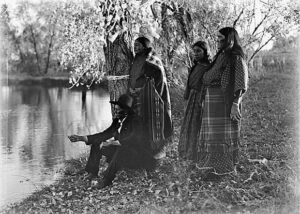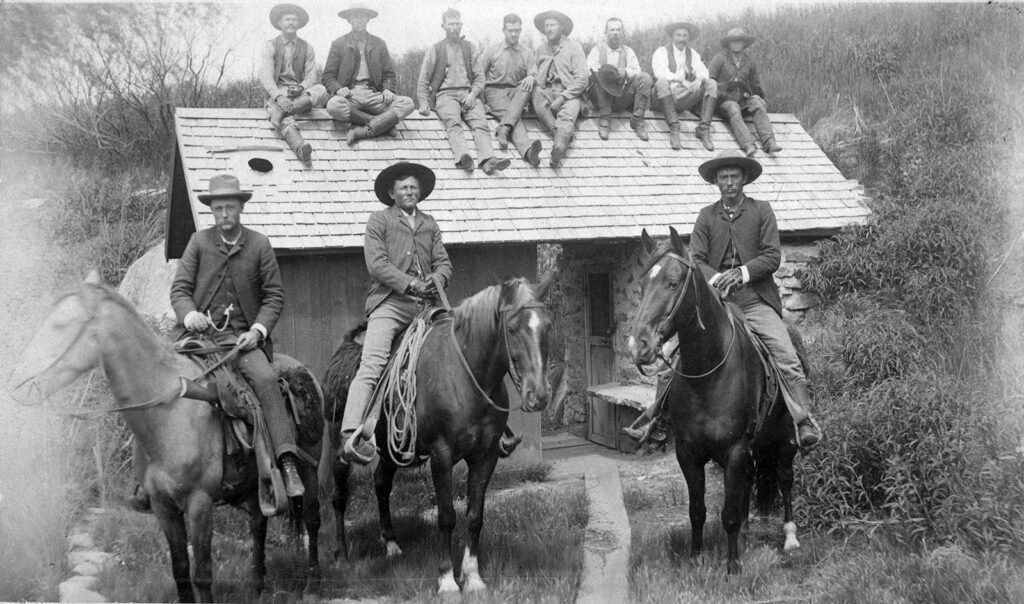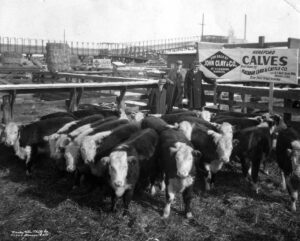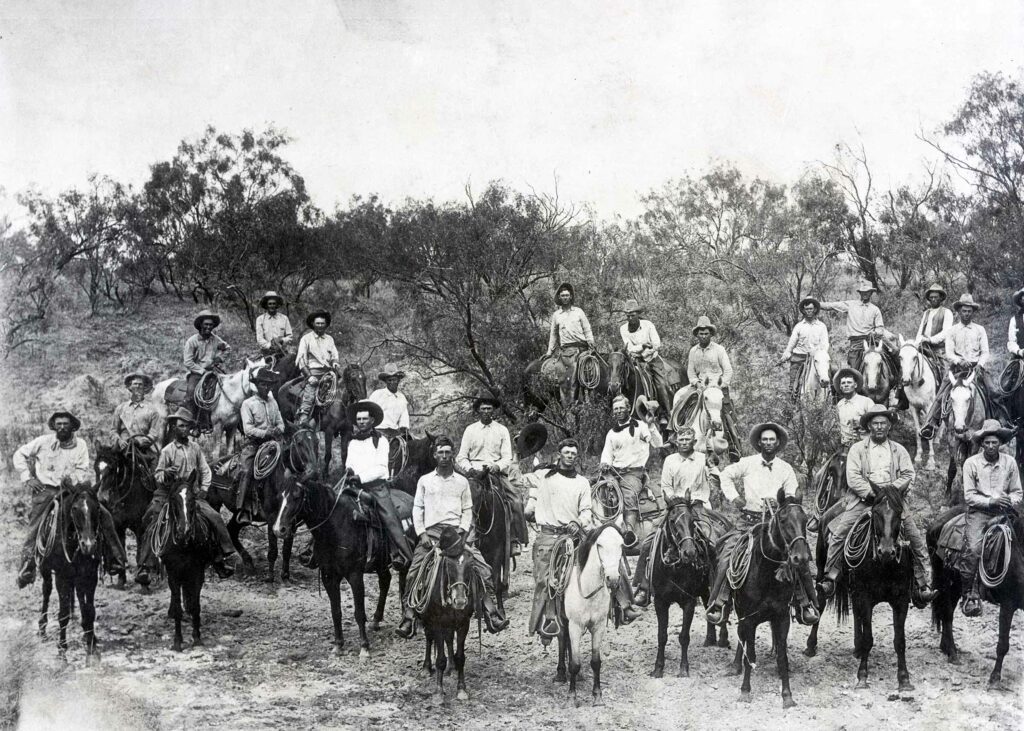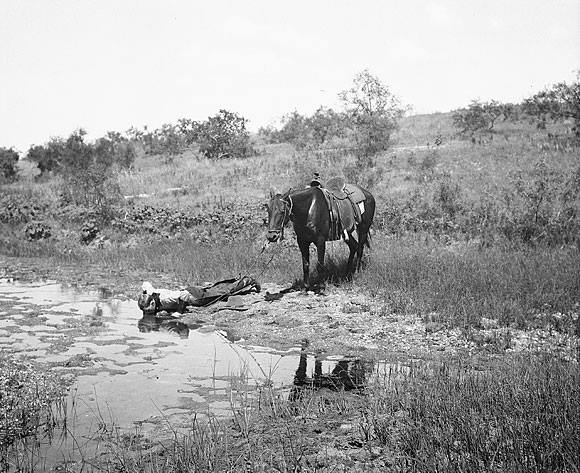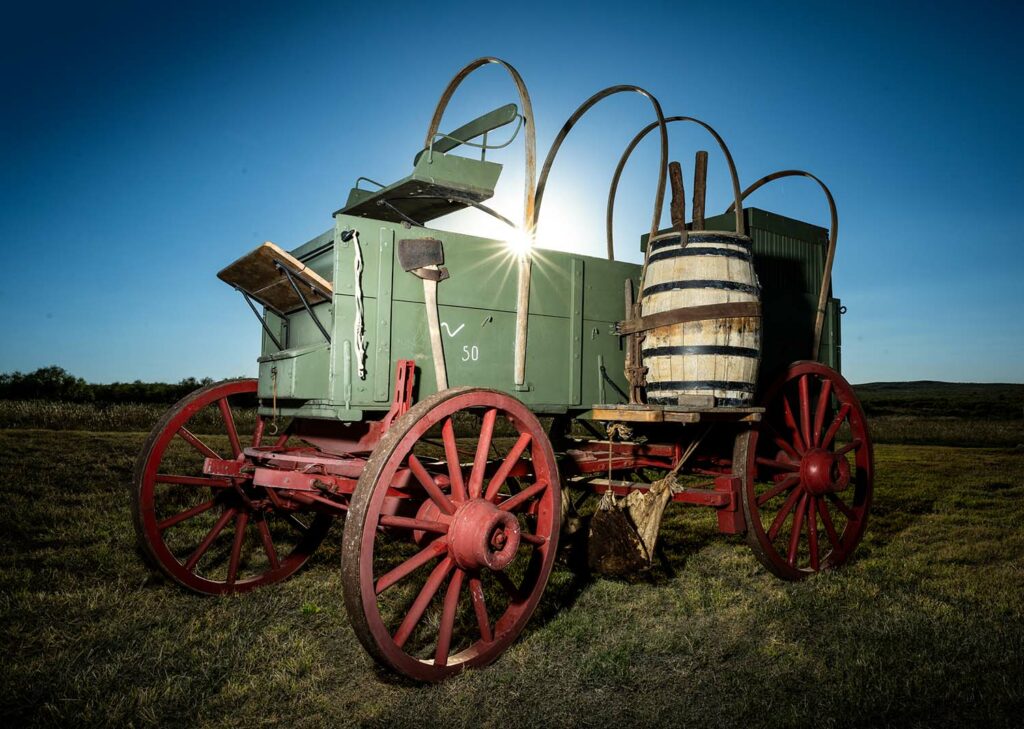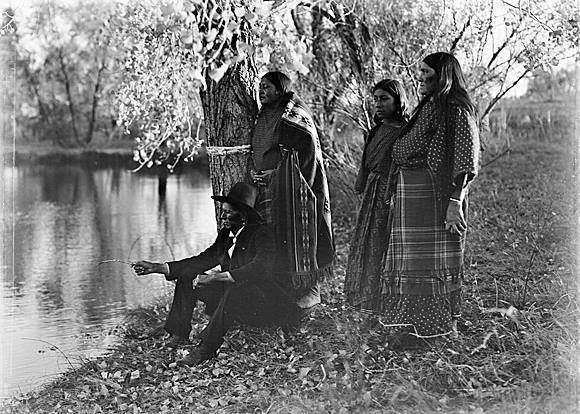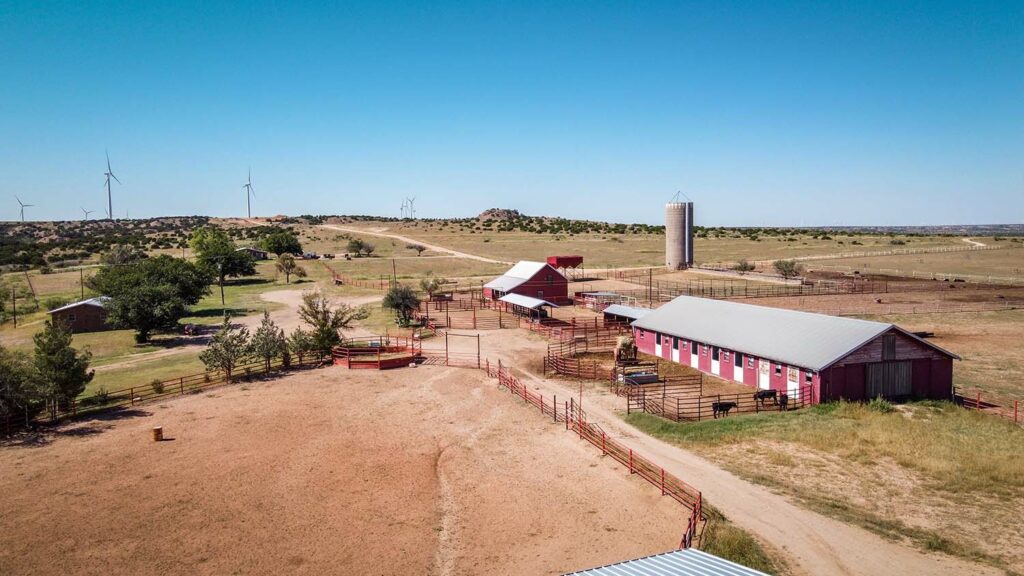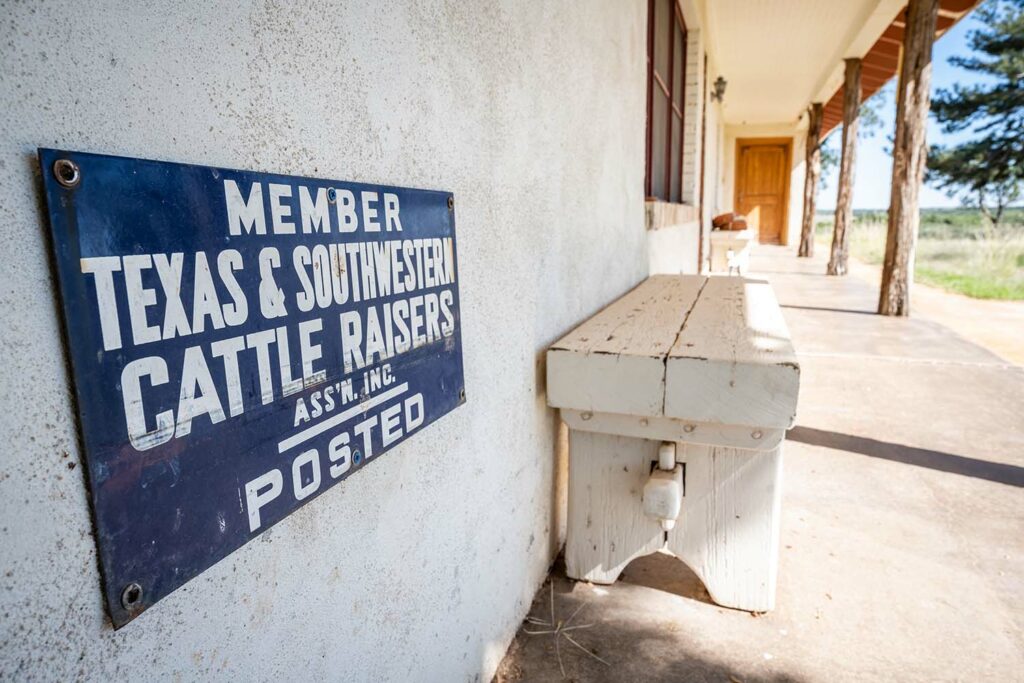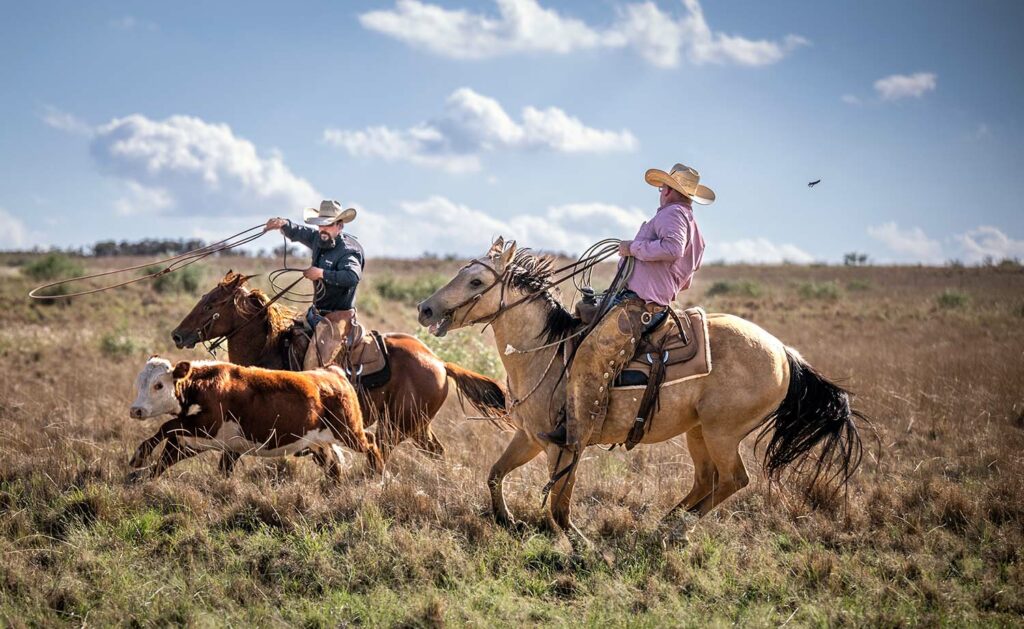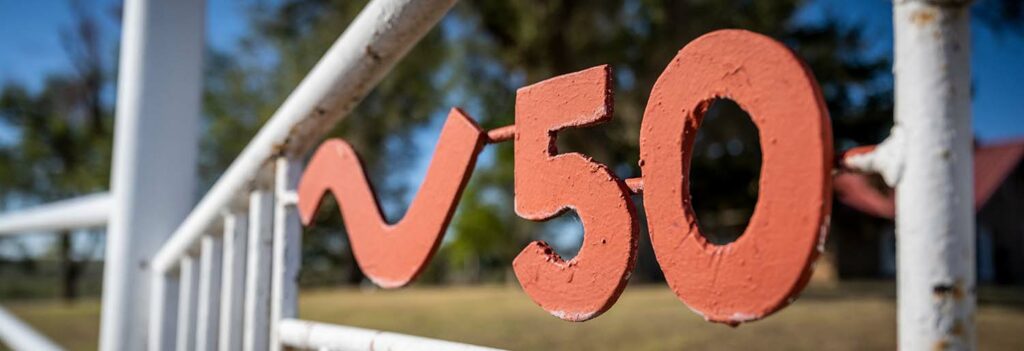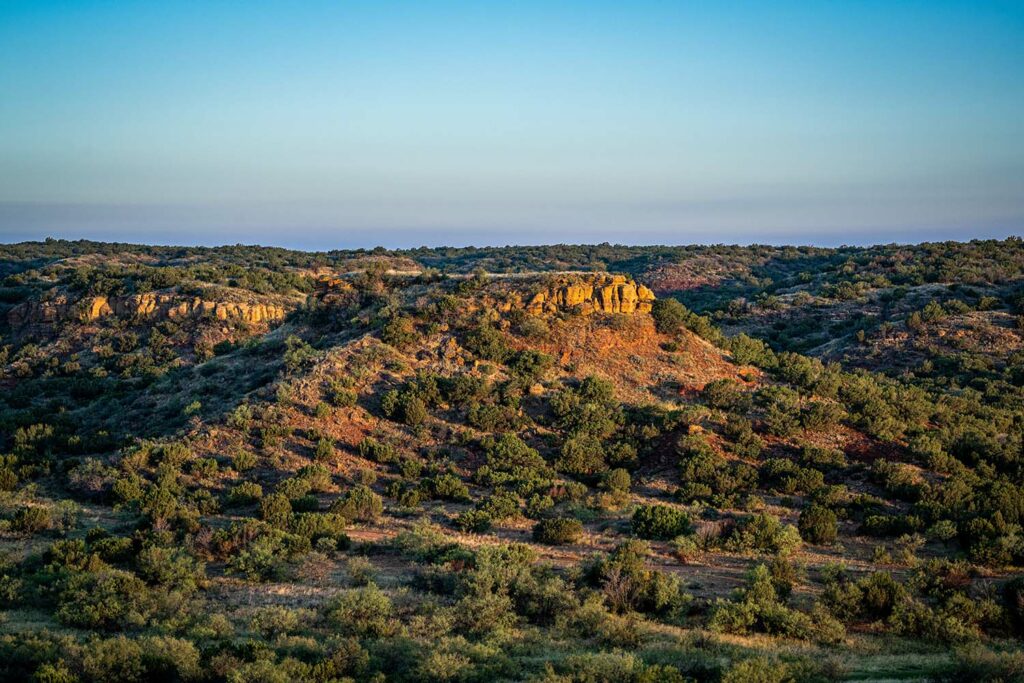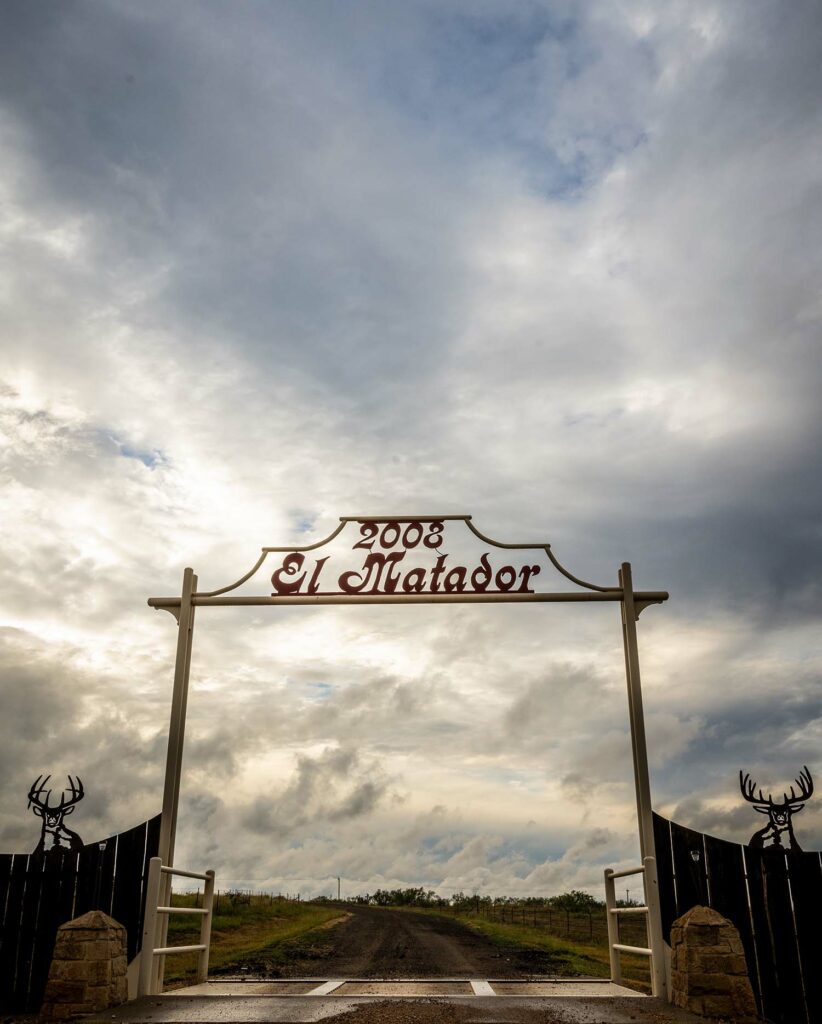About Matador Ranch
The history behind an iconic working ranch
For more than 140 years, the Matador Ranch has been a vibrant, colorful, cutting-edge cattle operation located in the southeast corner of the Texas Panhandle, about 90 minutes northeast of Lubbock.
Its rich history includes diverse ownership, timely expansion to adequately handle growing herds and dynamic leadership that routinely placed the Matador Ranch at the pinnacle of the cattle industry.
From that day in the fall of 1878 when Henry H. Campbell and Alfred M. Britton began their partnership with the purchase of a small herd and grazing rights from Joe Browning at Ballard Springs in Motley County until present day, the Matador Ranch and Matador Cattle Company have justifiably earned their positions as a true historic ranch.
Our Story
It’s unlikely that Joe Browning had any inkling of the future “el coloso” his seemingly mundane, $600 transaction with Henry H. “Hank” Campbell and Col. Alfred M. Britton would launch in the early winter of 1879. Thus, the legend of the Matador begins.
It was then that Campbell, a Civil War survivor and veteran Texas cattleman, and Britton, a Chicago banker, started the Matador Ranch on the Llano Estacado at a location known as Ballard Springs in Motley County following Campbell’s purchase of a small herd of cattle and range rights from Browning. The abandoned dugout that became their headquarters was named after its builder and first occupant, buffalo hunter Andrew Jackson Ballard.
The two partners had met in 1878 after Campbell drove a herd from the Rolling Plains to Chicago. While there he was among a group of cattlemen invited to a luncheon called by local bankers who were excited about the high profitability of the Texas cattle industry. Campbell reportedly had earned a gross profit of $14 per head on the cattle he had paid $9 per in Texas.
Following the meeting, Campbell found himself in possession of a good sum of Col. Britton’s money and instructions to return back to Texas to locate and purchase suitable range land and livestock. He did exactly that.
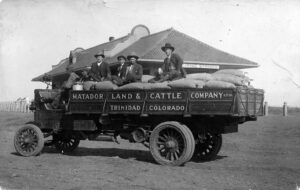
Matador Cowboys at the Roaring Springs Depot in 1914
In early 1879 the Matador Cattle Company, reportedly 320 acres and a small Longhorn herd, was formed under the laws of Texas with an initial outlay of $50,000 in capital stock. Joining the two partners at the time were Spottswood W. Lomax and John W. Nichols of Fort Worth and Britton’s brother-in-law, a Mr. Cata of New York. Each invested $10,000 to fund the venture. It is believed that Lomax, a Spanish literature aficionado, gave the ranch its moniker, and the “50M” brand, signifying the start-up investment, was originated as well.
Within the next few years their modest holdings grew exponentially. Smaller herds were purchased, including 1,300 head from John Dawson, and 8,000 head of “jinglebob” (a cross between Shorthorn bulls and Texas cows marked by split ears on both sides) which were believed to be the remnants of the John Chisum herd brought northeast from the Pecos in New Mexico. These cattle carried the “flying V” brand, which was adopted as the Matador mark from that time through present day.
With the purchase of each herd came additional range without additional costs. In his book “The Matador Land and Cattle Company,” author William H. Pearce explained: “With newly acquired herds the purchaser usually ‘inherited’ the range rights claimed by the seller. In the absence of actual landowners, and since statutory laws and mean of their enforcement were remote, a body of custom developed to keep disorder and confusion at a minimum. Range rights and privileges were established by occupation and were recognized as long as a claimant utilized his range and was strong enough to discourage interlopers. It was generally accepted that a rancher controlling a stream or one of its banks held range rights on the land extending away from the stream to divide separating his stream basin from an adjacent watershed.”
“Efforts were made to keep cattle within recognized ranges by a system of patrolling called ‘line riding,’ since no fences were present to separate the holdings of neighboring cattlemen and cattle were no respecters of boundaries. Line riders, moving daily along the borders of ranges, drifted the cattle toward the range claimed by their respective owners. The acquisition of title to lands bordering the watering places strengthened range rights by giving to the landowner a legal position on which to base his claims to privilege.”
This practice was a windfall for Campbell and company. By 1882 they claimed a range covering approximately 1.5 million acres (owned and leased) of land located mostly in Motley County as well as parts of Cottle, Dickens and Floyd counties. The area was so vast and provided so many nooks and crannies that it was documented that there were rogue cows found on the land that had roamed it unchecked for as many as 10 years.
Ironically, this picturesque wedge-shaped region — with its deep canyons, checkered hills, more-than-adequate annual rainfall (as well as water provided by the North, Middle and South Pease Rivers and their tributaries), reddish-brown soil that produced a variety of hearty grasses and elevation that ranged from 3,000 feet on the western boundary to 2,000 feet on the eastern edge — was relatively unknown and certainly unused a mere century before the cattle took hold. The primary residents were Comanches, Comancheros and buffalo hunters.
Capt. Clarence Mauck, under the command of Col. Ranald Mackenzie, led campaigns in 1872 and 1874 that quelled the threat of the Indians and their cohorts on the High Plains and confined their activities. That cleared the way for the hunters, who quickly slaughtered the herds of the southern plains. By 1878, the bison were largely eradicated, and the tribes gone. These events paved the way for settlers to begin migrating to the area to claim what was open Texas land at the time and, of course, the small, independent ranchers.
Less than four years later, and after considerable growth in both acreage and cattle, the partners parlayed their modest investment into a $1.25 million sale to a group of foreign investors from Dundee, Scotland. On December 4, 1882, the Matador Cattle Company became the Matador Land and Cattle Company, Limited, with, according to the purchase agreement, “about 100,000 acres of land held in fee simple … all range and other rights and privileges in or over 1,500,000 acres … 40,000 head of cattle, 14 yoke of oxen, 265 horses and fencing improvements.” Those two soon-to-be famous brands were also included.
News of spiraling success in the western United States in timber, mining and cattle had drawn the serious attention of the Scots and other Britons. The British government, in fact, sent a commission to the Western states to explore the range cattle industry, reporting in 1880 that profits of up to “33 percent” were possible. Shortly thereafter, an agent Thomas Lawson, was hired by the Dundee group to conduct an appraisal of the holdings of the Matador Cattle Company. Lawson’s glowing prospectus certainly helped seal the deal.
“The Ranch seems to me to be quite capable of carrying at least 80,000 cattle … and grazing them well. It has abundant supply of water, convenient for grass, and ample shelter for stock during hard weather; is at an elevation where nights are cool and cattle can rest; at a latitude where winters are comparatively safe. It is without doubt one of the best watered, sheltered, and healthiest Ranches in Texas.”
Within weeks the transaction was completed, beginning seven decades of Scottish control and expansion. It was the Scots who developed their holdings into one of the preeminent cattle empires in all North America, at one point encompassing more than a million acres-plus owned and leased in multiple states and Canada and more than 97,000 cattle.
First and foremost, they treated their acquisition as a long-term business enterprise; using their experience in investment and mortgage banking and a knowledge of animal husbandry in their own country to establish policy and procedure, keep tight reins on their American agents and dictate annual financial requirements. Their focus was to steadily improve the quality of the herd and make physical improvements to the property, even at the expense of dividends to investors.
Pearce summarized, “The Matador history is largely one of success achieved through the outstanding abilities of the company’s agents and strong leadership in the home office.”
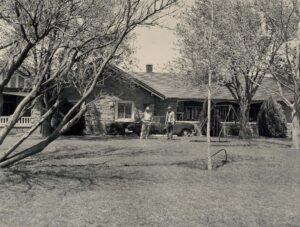
Matador Ranch Headquarters
Campbell, who termed the Matador “cattle heaven” because of its waves of nutritional buffalo and blue stem grasses and more than adequate supply of water from easy-to-access springs and creeks, and Britton were retained as ranch superintendent and company manager, respectively. Immediately their expertise was recognized. At the urging of the pair, the new board of directors approved the acquisition of 203,000 additional acres within the range and 22,000 cattle that same winter.
Over time, the Scots’ business policies and requirements, especially those of regular and accurate reporting and prospectus and adherence to a strict chain of communication from the home office in Dundee to the new American office in Fort Worth, wore on Campbell. While he retained most control over the range and cattle operations, he now had to take other key instructions from assistant manager William Sommerville. It was a severe departure from the days of total autonomy he enjoyed as an owner. He stepped down in 1891.
By the end of Campbell’s time as manager, the ranch had ballooned to 1.5 million acres and 70,000-plus head. He had built the first house on the property. He had orchestrated the construction of corrals, wells, water tanks and windmills, essential to the survival of cattle during times of drought and blizzard. He had fenced in portions of the interior property to establish separate pastures for horses, steers and cows and calves. By 1888 he had fenced the entirety of the Matador.
He later founded the town of Matador on a section of land he purchased northeast of Ballard Springs. He was named Motley County’s first judge and served for two years. He died in 1911.
Campbell’s replacement was a Scot-turned-U.S. citizen named Murdo Mackenzie, who had come to the states in 1885 to manage the Prairie Cattle Company, Limited, in southeastern Colorado and parts of New Mexico and the Texas Panhandle. Mackenzie would leave his indelible mark on both the Matador and the cattle industry during two stints (1891-1911 and 1922-36) as GM.
During those early years and into the first quarter of the 20th Century, the Matador faced the normal challenges of the day, including inaccurate and incomplete maps and surveys, erroneous fence lines, growing numbers of homesteaders laying claim to state school land leased by the ranch, ambiguous and ever-changing legislation from Austin and Washington, taxation from both sides of the Atlantic, economic downturns, disease, quarantine lines, rustlers, and, of course, severe weather (namely drought), which constantly threatened the quality and quantity of the herd.
Mackenzie tackled them head on. Initially he created management layers that made operations smoother and leaner, and implemented a strict labor code for the ranch’s cowboys, also known as Matadors. He constantly upgraded the ranch’s herd, often spending top dollar for prime bulls and cows and culling older, underweight and in-bred stock. He replaced fences and solidified the ranch boundaries, always improving the property.
A severe drought in 1892 forced many smaller ranchers into bankruptcy and threatened to diminish the Matador herd. Realizing the peril, Mackenzie contracted with the Francklyn Land and Cattle Company in 1893 to lease the White Deer pasture, 348,000 acres north in Carson and Gray counties. More than 10,000 Matador steers were kept on the land during the next three years. Herds were also driven to leased pastures in Kansas and South Dakota and then later to Canada and Montana.
Mackenzie’s commitment to quality beef and driving profits for the Dundee owners was clearly evident in his logistics: using the Ballard Springs spread as a breeding ground, sending yearling steers and heifers to White Deer for a year, and then driving or moving by train the two-year-olds to northern pastures for “double-wintering” before sending them to markets in Chicago, Omaha and Kansas City.
This practice became the Matador way: constantly upgrading the herd and always being on the lookout for quality grasslands to purchase or lease. Mackenzie knew the ranch could not accommodate 60,000-head-plus without degrading its pastures and water supply.
In 1902, the Matador purchased 210,000 acres of the XIT Ranch and establishes the Alamositas division along the Canadian River in Oldham County. Subsequent purchases around Alamositas grew the total land owned to 861,000 acres in 1910.
From 1904-1914, 500,000 acres were leased from the U.S. government in South Dakota on the Cheyenne River Indian Reservation. Between 50,000 and 150,000 acres were leased from Canada from 1905 through 1921. From 1913-1928, 500,000 acres were leased in Montana. The last of the big leases came between 1921-1926 when the Pine Ridge Indian Reservation in South Dakota provided 300,000 acres.
The end of those leases marked the return of the Matador as a strictly Texas operation. Skyrocketing expenses coupled with America’s desire for “younger beef” following World War I made the move necessary. By the mid-1920s, two-year-old beef was bringing top dollar. It meant the ranch could forego the northern feeding programs, avoid the costs of fattening cows for extra years while moving them to market quicker, and lessen the strain on the local pastures.
Through his affiliation and influence with organizations such as the Texas Cattle Raisers Association, Murdo Mackenzie became a strong voice for cattlemen everywhere, influencing everything from cattle safety and sanitation to railroad rates and routes, and meat-packer monopolistic practices to governmental policy, both on the state and national level.
In short, he helped transform the cattle industry from infancy to a modern business enterprise, from open range to enclosed ranch to feedlot-fed. His mark was so significant that President Theodore Roosevelt called him “the most influential of Western cattlemen,” and years later, in 1970, the National Food & Fiber Institute of Achievement recognized him as “the greatest individual contributor to the Western cattle industry.”
Mackenzie stepped down from his post in 1911 to manage a sprawling cattle ranch in Brazil. He was replaced by his nephew, John MacBain. During his tenure, MacBain negotiated and subsidized the first railroad to cross Matador land. In June 1913, the Quanah, Acme and Pacific completed its line from Quanah to Roaring Springs. A year later, ranch management displayed its strong desire to be a good neighbor by assisting the community of Matador pay for an eight-mile length of track connecting the town with the Quanah, Acme and Pacific line near Roaring Springs.
The railroad meant an influx of people, and in a departure from earlier sentiment wanting to keep “home seekers and farmers” away from its lands, the ranch sold thousands of acres to them. In 1929 the Matador board approved the building of the now-famous public swimming pool in Roaring Springs. Actions such as these helped build the towns of Matador and Roaring Springs. According to MacBain, “doing good and getting credit for it” was essential.
MacBain died unexpectedly in June 1922, and Mackenzie again took over the GM role until his son John Mackenzie succeeded him in 1937. The period was marked by the trying economic conditions of the Great Depression, alien land laws that limited foreigners from owning large tracts of U.S. land legislation and booming petroleum exploration. Matador lands were the site of some of that attention but yielded little if any results.
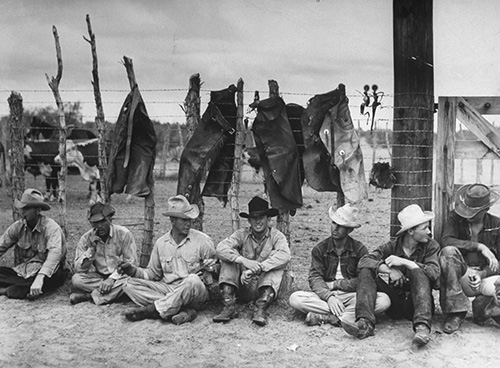
Cowboys drying their chaps on the Matador Ranch in 1940. Photo by Hansel Mieth for Life Magazine.
Amid continued oil and gas speculation around the Matador, the Scottish reign ended on July 31, 1951, when the American syndicate of Lazard Freres (Brothers) and Company acquired the ranch and livestock for $18.9 million. The sale reportedly included 400,000 acres at the Matador Division, 395,000 acres at Alamositas and 4,600 acres in Montana, as well as 46,000 head of cattle and 1,400 horses.
The new owner had plans to sell quickly, and immediately formed 15 different corporations and divided the ranch and livestock among them. Ten of the 15 were included at the Matador. Throughout the decade of the 1950s, various groups and individuals bought the operations or portions of them to begin their own ranching ventures or to sell to existing ranchers.
One of the significant buyers during that period was Kansas business tycoon and Texas native Fred Koch, who acquired three of the parcels (Rotadam, TeePee and Wolf Creek) which included approximately 110,000 acres of the Matador Division and ranch headquarters just southwest of the town of Matador. On Oct. 3, 1952, Koch’s Rock Island Oil and Refining Company incorporated the Matador Cattle Company, which earlier in the year had acquired the 300,000-acre plus Beaverhead Ranch in southwest Montana.
One of the growing problems the Koch Matador faced in the 1960s-70s was the continued spread of the mesquite tree, which was believed to have been introduced to the area in the late 1800s by horses and cattle driven from South Texas that had ingested the mesquite bean.
Thickets of Mesquite trees as tall as 10 feet covering more than 50 acres and dense enough to prevent horse and cowboy from entering, checkered the home range. Coupled with extremely rough terrain in pastures such as Croton Breaks on the south side of the Matador and East Salt Creek, it became increasingly difficult and time-consuming to locate and herd cattle, many never branded, that would run off any time a cowboy or horse got near and hide in these thickets and remain undetected for months and even years.
Over the years, dating back to 1920s, the Matador had gained somewhat of a notorious reputation among buyers for these so-called “outlaw” cattle that were termed “as wild as mountain bighorn sheep.” They were often underweight, would not add adequate poundage once they were corralled and moved to feed lots and, because of their unmanageable dispositions, were bad influences when mixed in with other normal cows.
The Koch Matador formed a two-pronged strategy to combat both the mesquite, which sucked up precious groundwater needed for healthy and ample grass, and rogue cattle issues.
First, a mesquite eradication program was begun in the 1960s and accelerated in the 1970s. By the late 1970s the growth of the troublesome tree was on the decline. It allowed the pastures to be revitalized, and it also made it easier for cowboys to find and round up the “outlaws.” It also made for more desirable habitat for the dove, quail, turkey and deer that have been in abundance since the ranch’s beginning.
This was coupled with a winter wheat-pasture feeding program begun in late 1968 when a herd of about 500 rogue and older cattle were transported to an open field in Plainview to start what would soon be a beneficial experiment. A year later there were 6,000 Matador head grazing on wheat fields in the Plainview area, and by 1972 the program was expanded to 40 to 50 pastures stretching to Littlefield, Muleshoe and Clovis, NM.
In addition to fattening up the cows, the time in wheat fields afforded Matador cowboys and employees an opportunity to completely transform the ornery streak of the “outlaws” through purposeful, gently handling, no longer the victims of “chousing.” By 1980 the change of disposition was being noticed and applauded by purchasers of the ranch’s stock.
Like the Scots before them, Koch managers were constantly striving for the highest genetic potential of their cattle. Bloodlines were important. Somewhere around 1910, the purebred bull “Publican” was discovered in the Matador pasture. “Publican” turned out to be the grandsire of “Prince Domino,” named in 1924 as the “best living Hereford bull” by the Hereford Journal.
Because Koch management believed it possessed two hundred of the best Hereford bulls to be found anywhere, it devised a plan to optimize this stellar gene pool. In 1973 it started a double-breeding program where bulls from both Beaverhead and Matador were shipped back and forth during the two ranches’ separate breeding seasons. This “double-duty” continued to enhance size and quality.
There was a similar commitment to quality for the horse population through careful breeding and culling and an occasional purchase to add to the breeding stock. It reached a pinnacle in 2013 when the Matador was tapped as winner of the Best Remuda Award by the American Quarter Horse Association.
In December 2021, Koch Industries sold its ranch holdings. The Collier family acquired a large portion of the Matador division, including the traditional headquarters.
In his 1989 book “Rich Grass and Sweet Water (Ranch Life With the Koch Matador Cattle Company), former company president John Lincoln wrote:
“The Matador Ranch has seen the evolution of the cowboy from 1879 to the present day. A typical cowboy in 1879 was usually a freedom-loving, carefree bachelor who slept in a bedroll and lived in the isolation of the far-sweeping Matador range. The modern cowboy is more likely to be a married man, with one or more children, and living in a modern dwelling. He spends his days on the same range but travels in a pickup pulling his horse in a trailer a great part of the time. He is a serious-minded young man who spends a lot of his time putting information about ranch activity into a computer, often doing it at night after a full day in the pastures. He very likely has a college degree in animal science. On the other hand, he may not have wanted to invest time and money in a college education, instead starting to follow a cow directly after high school. In either case, his goal usually is to manage the ranch on which he works. The early-day cowboy was an athlete on a horse, and the modern cowboy is equally so. Another that has not changed in this period of more than one hundred years is that both men have usually thought that they had the very best life in the world.”
Acknowledgement
The above condensed history of the Matador Ranch would not have been possible without the outstanding documentation, recollections, chronologies and writings from the following sources:
“The Matador Land and Cattle Company,” by W.M. Pearce, © University of Oklahoma Press, 1964
“A Decade in the History of The Matador Land and Cattle Company, Limited, 1919-1928,” Texas Technological College Master’s Thesis by Alfred E. Cornebise, 1958
“CEO on the Range: Murdo Mackenzie and the Matador Ranch in an Age of Reform 1891-1911,” Texas Tech University Master’s Thesis by Leland Turner, 1996
“Rich Grass and Sweet Water,” by John Lincoln, © Texas A&M University Press, 1989
“Life in the Saddle,” by Frank Collison, © University of Oklahoma Press, 1963
“Matador Ranch,” W.C. Holden, Texas State Historical Association, https://www.tshaonline.org
“Shrinking Giant,” by Kathryn Jones, Texas Monthly, August 1998
Timeline
From modest beginnings to a past rich with history and character
- 1877
AJ Ballard, a hunter from Lincoln, New Mexico, built a dugout near a spring that now bears his name - Early 1878
Buffalo hunter and cattleman Joe Browning lays claim to a half-section of land and dugout at Ballard Springs in Motley County - Fall 1878
Cattleman Henry H. Campbell and Chicago banker Alfred M. Britton enter into a partnership to locate land and cattle in Texas Panhandle - December 1879
Campbell purchases small herd and range rights from Browning, signaling the start of the Matador Ranch - Winter 1879
S.W. Lomax, John W. Nichols and a Mr. Cata (first name unknown) join the enterprise, which is incorporated as the Matador Cattle Company with initial capital of $50,000 - Dec. 23, 1882
Investors group from Dundee, Scotland, acquires the operation (approximately 100,000 acres and 40,000 head of cattle) for $1.25 million and becomes the Matador Land and Cattle Company, Limited - Winter 1883
Syndicate purchases additional 203,000 acres and 22,000 cattle within the range - 1892-93
Severe drought on the Matador range forces company to lease the White Deer pasture of 348,000 acres in Carson County - 1902
Matador purchases 210,000 acres of the XIT Ranch and establishes the Alamositas division along the Canadian River in Oldham County. Subsequent purchases around Alamositas grow the division to 800,000 acres - 1904-1914
500,000 acres leased from U.S. government in South Dakota on Cheyenne River Indian Reservation - 1905-1921
First 50,000 then 150,000 acres leased in Canada - 1910
With additional purchases, the Matador owned 861,000 acres in Texas and leased another 650,000 in northern pastures - 1913-1928
500,000 acres leased on Fort Belknap Indian Reservation in Montana - 1921-1926
300,000 acres leased on Pine Ridge Indian Reservation in South Dakota - July 1, 1951
American syndicate Lazard Brothers and Company of London purchases ranch (approximately 800,000 acres, 46,000 cattle, 1,500 horses) for $18.9 million and divides land and cattle among 15 parcels for resale - Oct. 3, 1952
Fred Koch buys three of the parcels, incorporating the Matador Cattle Company and locating ranch headquarters south of the town of Matador - Dec. 2021
The Collier family purchase the headquarters division of Matador Land & Cattle at Matador from Koch Industries, including 36,000 acres, cattle, horses, other improvements, and the legendary brands
Further Reading
With such a rich history, there are several online sources and publications containing additional information about the Matador Ranch. Browse some of these links to continue your journey down the rabbit hole.
The Matador Land and Cattle Company
by W.M. Pearce
Rich Grass and Sweet Water
by John Lincoln
The Big Ranch Country
by JW Williams
Motley County RoundUp: Over 100 Years of Gathering in Texas
by Marisue Burleson Potts
